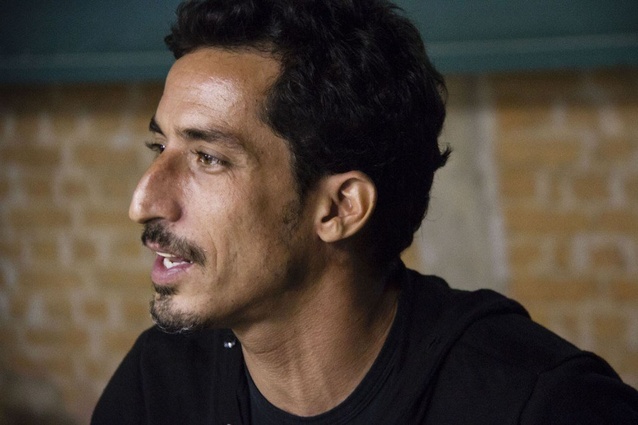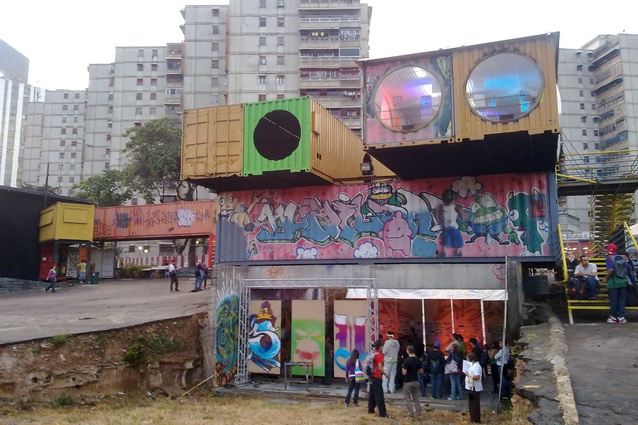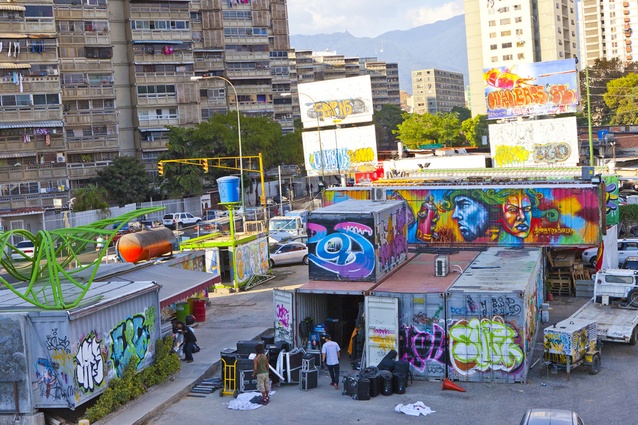Urban legend
The Milieu in which architect Alejandro Haiek works is one not familiar to all Antipodeans. Based in Caracas, Venezuela, he focuses on the renewal of unused spaces in impoverished urban neighbourhoods all over the world. He started out almost 20 years ago, with co-collaborator Eleanna Cadalso. Under the auspices of their studio, Lab.Pro.Fab, and in conjunction with community groups, they have repurposed vacant lots and parking buildings into community centres and cultural and sporting complexes, all the while making the spaces relevant to the people that live near them.

A recent project, Tiuna el Fuerte Cultural Park, transformed an abandoned area into a multi-use public space populated with recycled shipping containers. It won first prize in the International Festival of Architecture of Barcelona and the International Award for Public Art presented in Shanghai, China, last April.
In April, Haiek will come to New Zealand as Elam’s International Artist in Residence. The programme at the art school of The University of Auckland invites several cultural practitioners each year to spend eight-week stints at the school; while Haiek is here, he will work on an architectural project in post-earthquake Christchurch.
“He’s working between art, architecture and design, so there’s a fascinating hybridity about his practice,” says Jim Speers, Elam’s associate head of engagement and external relations. “What interests me is that he’s able to engage with local environments and is driven to produce something useful for the public and, at the same time, is developing a strong personal language around his own work.”
We caught up with Haiek whilst he was on a whirlwind trip to New Zealand prior to his residency and asked him about his work to date and his plans for his time in New Zealand.
Urbis: You’ve committed to using your studio, Lab.Pro.Fab, to improve public space in favelas and other disadvantaged communities. How did that mandate come about?
Alejandro Haiek: I tried to move to industrial design and also to urbanism [when I first trained as an architect] and used art to move around architecture. Eleanna moved from sculpture to architecture and industrial design. In the beginning, we were very subversive; we did installations in the middle of the night. Now, we are trying to make something that has the principles of architecture but is not architecture – hybrid objects. We are making something that is in between that. The value is how we can enhance the community. I’m an urban creative strategist. I’m a director of this lab but I work with a lot of people and students: volunteers who want to collaborate.
U: You’re also a teacher of architecture, aren’t you?
AH: I’ve been teaching for 16 years. We teach in Colombia, Chile, Puerto Rico, Ecuador. We teach at a university in Philadelphia. The architecture is the result of all that.
U: What’s your take on the state of contemporary architecture?
AH: The schools of architecture try to create Le Corbusiers. It’s all about towers and huge buildings. We have to invert this practice. The idea is to rethink how we produce the cities and work with the spaces in between different professions – art, design, etc. – using different materials, different uses to relate to the city. The goal could be just to understand the community and try to solve the problems. How can we be citizens? Art has to wait for galleries to exist, doctors have to wait for a financial transaction before they can help the sick, and it’s the same with architecture and the client. Some architects just wait for a client. A lot of them go to other countries to work with people because there are no projects [in their own countries]. But we have the responsibility to rethink our communities and use our skills to improve them.

U: You’ve just been to Christchurch to see what’s happening in disused spaces there. How did the trip go?
AH: A lot of art groups in the community are doing projects down there. There are political and economic interests as well. There is a problem with the infrastructure of the city and the condition of the plots. There are environmental problems also; what is going to happen to all the materials [from the builidings that are demolished]? The sound of the city is the sound of machines. There are a lot of machines and the sound there is unbelievable.
U: What do you think you’ll create there while you’re in New Zealand?
AH: I have a lot of ideas but it’s also about the time and the money. It’s easier to demolish a building and make a new one but we then delete the memory of the place. It’s more expensive to save rather than demolish but we need to improve art, culture and relations. The most important thing is to work with people who really need it and to create cultural dynamics. We will try to create a venue for social activity that’s temporary in nature. We have been talking about the meaning of transition. Transitional things can be cheaper than permanent structures. They are supposed to capture the past and the future. We will propose something that the community can run and maybe something for artists – an exhibition about memories and space. There is open space to be subversive in; anyone can do it.
U: What else are you working on?
AH: We are working with different groups in the favelas of Puerto Rico to make a plan, to workshop permaculture and traditional methods. In Bogatá, we’re talking about transforming abandoned buildings into public spaces. We have public art programmes in New York and Miami. We’ve just finished a pavilion in Tokyo and a container store in Shanghai.













